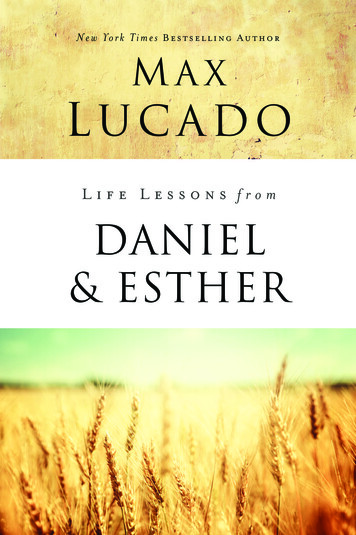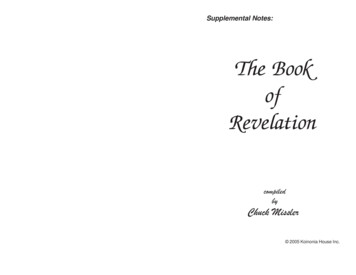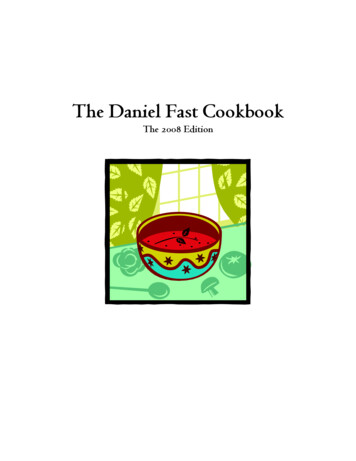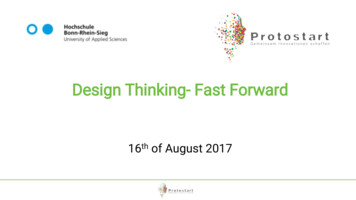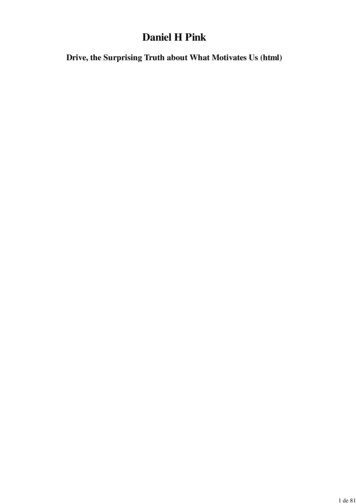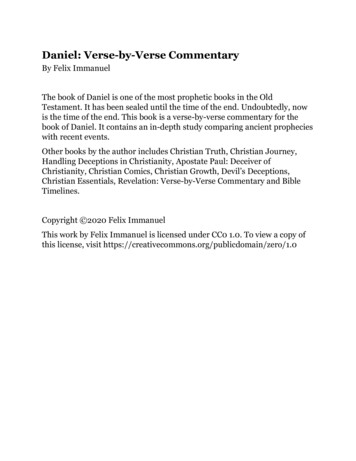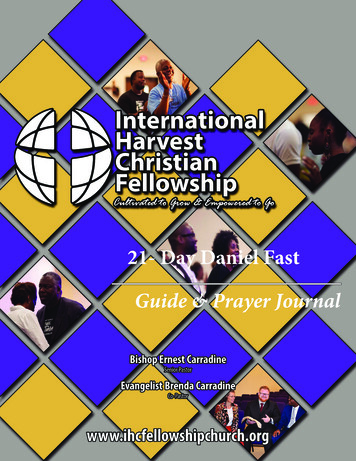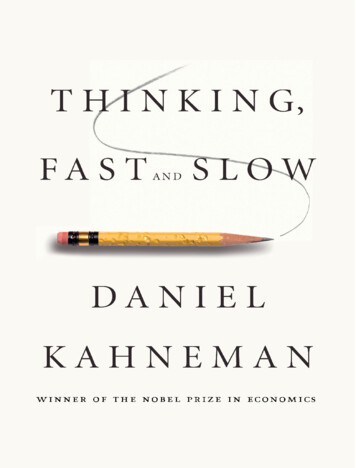
Transcription
In memory of Amos Tversky
ContentsIntroductionPart I. Two Systems1. The Characters of the Story2. Attention and Effort3. The Lazy Controller4. The Associative Machine5. Cognitive Ease6. Norms, Surprises, and Causes7. A Machine for Jumping to Conclusions8. How Judgments Happen9. Answering an Easier QuestionPart II. Heuristics and Biases10. The Law of Small Numbers 5 11. Anchors12. The Science of Availability13. Availability, Emotion, and Risk14. Tom W’s Specialty
15. Linda: Less is More16. Causes Trump Statistics17. Regression to the Mean18. Taming Intuitive PredictionsPart III. Overconfidence19. The Illusion of Understanding20. The Illusion of Validity21. Intuitions Vs. Formulas22. Expert Intuition: When Can We Trust It?23. The Outside View24. The Engine of CapitalismPart IV. Choices25. Bernoulli’s Errors26. Prospect Theory27. The Endowment Effect28. Bad Events29. The Fourfold Pattern30. Rare Events31. Risk Policies
32. Keeping Score33. Reversals34. Frames and RealityPart V. Two Selves35. Two Selves36. Life as a Story37. Experienced Well-Being38. Thinking About ix B: Choices, Values, and FramesAcknowledgmentsNotesIndexUnder
IntroductionEvery author, I suppose, has in mind a setting in which readers of his or herwork could benefit from having read it. Mine is the proverbial officewatercooler, where opinions are shared and gossip is exchanged. I hopeto enrich the vocabulary that people use when they talk about thejudgments and choices of others, the company’s new policies, or acolleague’s investment decisions. Why be concerned with gossip?Because it is much easier, as well as far more enjoyable, to identify andlabel the mistakes of others than to recognize our own. Questioning whatwe believe and want is difficult at the best of times, and especially difficultwhen we most need to do it, but we can benefit from the informed opinionsof others. Many of us spontaneously anticipate how friends and colleagueswill evaluate our choices; the quality and content of these anticipatedjudgments therefore matters. The expectation of intelligent gossip is apowerful motive for serious self-criticism, more powerful than New Yearresolutions to improve one’s decision making at work and at home.To be a good diagnostician, a physician needs to acquire a large set oflabels for diseases, each of which binds an idea of the illness and itssymptoms, possible antecedents and causes, possible developments andconsequences, and possible interventions to cure or mitigate the illness.Learning medicine consists in part of learning the language of medicine. Adeeper understanding of judgments and choices also requires a richervocabulary than is available in everyday language. The hope for informedgossip is that there are distinctive patterns in the errors people make.Systematic errors are known as biases, and they recur predictably inparticular circumstances. When the handsome and confident speakerbounds onto the stage, for example, you can anticipate that the audiencewill judge his comments more favorably than he deserves. The availabilityof a diagnostic label for this bias—the halo effect—makes it easier toanticipate, recognize, and understand.When you are asked what you are thinking about, you can normallyanswer. You believe you know what goes on in your mind, which oftenconsists of one conscious thought leading in an orderly way to another. Butthat is not the only way the mind works, nor indeed is that the typical way.Most impressions and thoughts arise in your conscious experience withoutyour knowing how they got there. You cannot tracryd e how you came tothe belief that there is a lamp on the desk in front of you, or how youdetected a hint of irritation in your spouse’s voice on the telephone, or how
you managed to avoid a threat on the road before you became consciouslyaware of it. The mental work that produces impressions, intuitions, andmany decisions goes on in silence in our mind.Much of the discussion in this book is about biases of intuition. However,the focus on error does not denigrate human intelligence, any more thanthe attention to diseases in medical texts denies good health. Most of usare healthy most of the time, and most of our judgments and actions areappropriate most of the time. As we navigate our lives, we normally allowourselves to be guided by impressions and feelings, and the confidencewe have in our intuitive beliefs and preferences is usually justified. But notalways. We are often confident even when we are wrong, and an objectiveobserver is more likely to detect our errors than we are.So this is my aim for watercooler conversations: improve the ability toidentify and understand errors of judgment and choice, in others andeventually in ourselves, by providing a richer and more precise language todiscuss them. In at least some cases, an accurate diagnosis may suggestan intervention to limit the damage that bad judgments and choices oftencause.OriginsThis book presents my current understanding of judgment and decisionmaking, which has been shaped by psychological discoveries of recentdecades. However, I trace the central ideas to the lucky day in 1969 when Iasked a colleague to speak as a guest to a seminar I was teaching in theDepartment of Psychology at the Hebrew University of Jerusalem. AmosTversky was considered a rising star in the field of decision research—indeed, in anything he did—so I knew we would have an interesting time.Many people who knew Amos thought he was the most intelligent personthey had ever met. He was brilliant, voluble, and charismatic. He was alsoblessed with a perfect memory for jokes and an exceptional ability to usethem to make a point. There was never a dull moment when Amos wasaround. He was then thirty-two; I was thirty-five.Amos told the class about an ongoing program of research at theUniversity of Michigan that sought to answer this question: Are peoplegood intuitive statisticians? We already knew that people are goodintuitive grammarians: at age four a child effortlessly conforms to the rulesof grammar as she speaks, although she has no idea that such rules exist.Do people have a similar intuitive feel for the basic principles of statistics?Amos reported that the answer was a qualified yes. We had a lively debatein the seminar and ultimately concluded that a qualified no was a better
answer.Amos and I enjoyed the exchange and concluded that intuitive statisticswas an interesting topic and that it would be fun to explore it together. ThatFriday we met for lunch at Café Rimon, the favorite hangout of bohemiansand professors in Jerusalem, and planned a study of the statisticalintuitions of sophisticated researchers. We had concluded in the seminarthat our own intuitions were deficient. In spite of years of teaching andusing statistics, we had not developed an intuitive sense of the reliability ofstatistical results observed in small samples. Our subjective judgmentswere biased: we were far too willing to believe research findings based oninadequate evidence and prone to collect too few observations in our ownresearch. The goal of our study was to examine whether other researcherssuffered from the same affliction.We prepared a survey that included realistic scenarios of statisticalissues that arise in research. Amos collected the responses of a group ofexpert participants in a meeting of the Society of MathematicalPsychology, including the authors of two statistical textbooks. As expected,we found that our expert colleagues, like us, greatly exaggerated thelikelihood that the original result of an experiment would be successfullyreplicated even with a small sample. They also gave very poor advice to afictitious graduate student about the number of observations she neededto collect. Even statisticians were not good intuitive statisticians.While writing the article that reported these findings, Amos and Idiscovered that we enjoyed working together. Amos was always veryfunny, and in his presence I became funny as well, so we spent hours ofsolid work in continuous amusement. The pleasure we found in workingtogether made us exceptionally patient; it is much easier to strive forperfection when you are never bored. Perhaps most important, wechecked our critical weapons at the door. Both Amos and I were criticaland argumentative, he even more than I, but during the years of ourcollaboration neither of us ever rejected out of hand anything the othersaid. Indeed, one of the great joys I found in the collaboration was thatAmos frequently saw the point of my vague ideas much more clearly than Idid. Amos was the more logical thinker, with an orientation to theory andan unfailing sense of direction. I was more intuitive and rooted in thepsychology of perception, from which we borrowed many ideas. We weresufficiently similar to understand each other easily, and sufficiently differentto surprise each other. We developed a routine in which we spent much ofour working days together, often on long walks. For the next fourteen yearsour collaboration was the focus of our lives, and the work we did togetherduring those years was the best either of us ever did.We quickly adopted a practice that we maintained for many years. Our
research was a conversation, in which we invented questions and jointlyexamined our intuitive answers. Each question was a small experiment,and we carried out many experiments in a single day. We were notseriously looking for the correct answer to the statistical questions weposed. Our aim was to identify and analyze the intuitive answer, the firstone that came to mind, the one we were tempted to make even when weknew it to be wrong. We believed—correctly, as it happened—that anyintuition that the two of us shared would be shared by many other peopleas well, and that it would be easy to demonstrate its effects on judgments.We once discovered with great delight that we had identical silly ideasabout the future professions of several toddlers we both knew. We couldidentify the argumentative three-year-old lawyer, the nerdy professor, theempathetic and mildly intrusive psychotherapist. Of course thesepredictions were absurd, but we still found them appealing. It was alsoclear that our intuitions were governed by the resemblance of each child tothe cultural stereotype of a profession. The amusing exercise helped usdevelop a theory that was emerging in our minds at the time, about the roleof resemblance in predictions. We went on to test and elaborate thattheory in dozens of experiments, as in the following example.As you consider the next question, please assume that Steve wasselected at random from a representative sample:An individual has been described by a neighbor as follows:“Steve is very shy and withdrawn, invariably helpful but with littleinterest in people or in the world of reality. A meek and tidy soul,he has a need for order and structurut and stre, and a passion fordetail.” Is Steve more likely to be a librarian or a farmer?The resemblance of Steve’s personality to that of a stereotypical librarianstrikes everyone immediately, but equally relevant statisticalconsiderations are almost always ignored. Did it occur to you that thereare more than 20 male farmers for each male librarian in the UnitedStates? Because there are so many more farmers, it is almost certain thatmore “meek and tidy” souls will be found on tractors than at libraryinformation desks. However, we found that participants in our experimentsignored the relevant statistical facts and relied exclusively on resemblance.We proposed that they used resemblance as a simplifying heuristic(roughly, a rule of thumb) to make a difficult judgment. The reliance on theheuristic caused predictable biases (systematic errors) in theirpredictions.On another occasion, Amos and I wondered about the rate of divorceamong professors in our university. We noticed that the question triggered
a search of memory for divorced professors we knew or knew about, andthat we judged the size of categories by the ease with which instancescame to mind. We called this reliance on the ease of memory search theavailability heuristic. In one of our studies, we asked participants to answera simple question about words in a typical English text:Consider the letter K.Is K more likely to appear as the first letter in a word OR as thethird letter?As any Scrabble player knows, it is much easier to come up with wordsthat begin with a particular letter than to find words that have the sameletter in the third position. This is true for every letter of the alphabet. Wetherefore expected respondents to exaggerate the frequency of lettersappearing in the first position—even those letters (such as K, L, N, R, V)which in fact occur more frequently in the third position. Here again, thereliance on a heuristic produces a predictable bias in judgments. Forexample, I recently came to doubt my long-held impression that adultery ismore common among politicians than among physicians or lawyers. I hadeven come up with explanations for that “fact,” including the aphrodisiaceffect of power and the temptations of life away from home. I eventuallyrealized that the transgressions of politicians are much more likely to bereported than the transgressions of lawyers and doctors. My intuitiveimpression could be due entirely to journalists’ choices of topics and to myreliance on the availability heuristic.Amos and I spent several years studying and documenting biases ofintuitive thinking in various tasks—assigning probabilities to events,forecasting the future, assessing hypotheses, and estimating frequencies.In the fifth year of our collaboration, we presented our main findings inScience magazine, a publication read by scholars in many disciplines. Thearticle (which is reproduced in full at the end of this book) was titled“Judgment Under Uncertainty: Heuristics and Biases.” It described thesimplifying shortcuts of intuitive thinking and explained some 20 biases asmanifestations of these heuristics—and also as demonstrations of the roleof heuristics in judgment.Historians of science have often noted that at any given time scholars ina particular field tend to share basic re share assumptions about theirsubject. Social scientists are no exception; they rely on a view of humannature that provides the background of most discussions of specificbehaviors but is rarely questioned. Social scientists in the 1970s broadlyaccepted two ideas about human nature. First, people are generally
rational, and their thinking is normally sound. Second, emotions such asfear, affection, and hatred explain most of the occasions on which peopledepart from rationality. Our article challenged both assumptions withoutdiscussing them directly. We documented systematic errors in the thinkingof normal people, and we traced these errors to the design of themachinery of cognition rather than to the corruption of thought by emotion.Our article attracted much more attention than we had expected, and itremains one of the most highly cited works in social science (more thanthree hundred scholarly articles referred to it in 2010). Scholars in otherdisciplines found it useful, and the ideas of heuristics and biases havebeen used productively in many fields, including medical diagnosis, legaljudgment, intelligence analysis, philosophy, finance, statistics, and militarystrategy.For example, students of policy have noted that the availability heuristichelps explain why some issues are highly salient in the public’s mind whileothers are neglected. People tend to assess the relative importance ofissues by the ease with which they are retrieved from memory—and this islargely determined by the extent of coverage in the media. Frequentlymentioned topics populate the mind even as others slip away fromawareness. In turn, what the media choose to report corresponds to theirview of what is currently on the public’s mind. It is no accident thatauthoritarian regimes exert substantial pressure on independent media.Because public interest is most easily aroused by dramatic events and bycelebrities, media feeding frenzies are common. For several weeks afterMichael Jackson’s death, for example, it was virtually impossible to find atelevision channel reporting on another topic. In contrast, there is littlecoverage of critical but unexciting issues that provide less drama, such asdeclining educational standards or overinvestment of medical resources inthe last year of life. (As I write this, I notice that my choice of “little-covered”examples was guided by availability. The topics I chose as examples arementioned often; equally important issues that are less available did notcome to my mind.)We did not fully realize it at the time, but a key reason for the broadappeal of “heuristics and biases” outside psychology was an incidentalfeature of our work: we almost always included in our articles the full text ofthe questions we had asked ourselves and our respondents. Thesequestions served as demonstrations for the reader, allowing him torecognize how his own thinking was tripped up by cognitive biases. I hopeyou had such an experience as you read the question about Steve thelibrarian, which was intended to help you appreciate the power ofresemblance as a cue to probability and to see how easy it is to ignorerelevant statistical facts.
The use of demonstrations provided scholars from diverse disciplines—notably philosophers and economists—an unusual opportunity to observepossible flaws in their own thinking. Having seen themselves fail, theybecame more likely to question the dogmatic assumption, prevalent at thetime, that the human mind is rational and logical. The choice of methodwas crucial: if we had reported results of only conventional experiments,the article would have been less noteworthy and less memorable.Furthermore, skeptical readers would have distanced themselves from theresults by attributing judgment errors to the familiar l the famifecklessnessof undergraduates, the typical participants in psychological studies. Ofcourse, we did not choose demonstrations over standard experimentsbecause we wanted to influence philosophers and economists. Wepreferred demonstrations because they were more fun, and we were luckyin our choice of method as well as in many other ways. A recurrent themeof this book is that luck plays a large role in every story of success; it isalmost always easy to identify a small change in the story that would haveturned a remarkable achievement into a mediocre outcome. Our story wasno exception.The reaction to our work was not uniformly positive. In particular, ourfocus on biases was criticized as suggesting an unfairly negative view ofthe mind. As expected in normal science, some investigators refined ourideas and others offered plausible alternatives. By and large, though, theidea that our minds are susceptible to systematic errors is now generallyaccepted. Our research on judgment had far more effect on social sciencethan we thought possible when we were working on it.Immediately after completing our review of judgment, we switched ourattention to decision making under uncertainty. Our goal was to develop apsychological theory of how people make decisions about simplegambles. For example: Would you accept a bet on the toss of a coin whereyou win 130 if the coin shows heads and lose 100 if it shows tails?These elementary choices had long been used to examine broadquestions about decision making, such as the relative weight that peopleassign to sure things and to uncertain outcomes. Our method did notchange: we spent many days making up choice problems and examiningwhether our intuitive preferences conformed to the logic of choice. Hereagain, as in judgment, we observed systematic biases in our owndecisions, intuitive preferences that consistently violated the rules ofrational choice. Five years after the Science article, we published“Prospect Theory: An Analysis of Decision Under Risk,” a theory of choicethat is by some counts more influential than our work on judgment, and isone of the foundations of behavioral economics.
Until geographical separation made it too difficult to go on, Amos and Ienjoyed the extraordinary good fortune of a shared mind that was superiorto our individual minds and of a relationship that made our work fun as wellas productive. Our collaboration on judgment and decision making was thereason for the Nobel Prize that I received in 2002, which Amos would haveshared had he not died, aged fifty-nine, in 1996.Where we are nowThis book is not intended as an exposition of the early research that Amosand I conducted together, a task that has been ably carried out by manyauthors over the years. My main aim here is to present a view of how themind works that draws on recent developments in cognitive and socialpsychology. One of the more important developments is that we nowunderstand the marvels as well as the flaws of intuitive thought.Amos and I did not address accurate intuitions beyond the casualstatement that judgment heuristics “are quite useful, but sometimes lead tosevere and systematic errors.” We focused on biases, both because wefound them interesting in their own right and because they providedevidence for the heuristics of judgment. We did not ask ourselves whetherall intuitive judgments under uncertainty are produced by the heuristics westudied; it is now clear that they are not. In particular, the accurate intuitionsof experts are better explained by the effects of prolonged practice than byheuristics. We can now draw a richer andigha riche more balancedpicture, in which skill and heuristics are alternative sources of intuitivejudgments and choices.The psychologist Gary Klein tells the story of a team of firefighters thatentered a house in which the kitchen was on fire. Soon after they startedhosing down the kitchen, the commander heard himself shout, “Let’s getout of here!” without realizing why. The floor collapsed almost immediatelyafter the firefighters escaped. Only after the fact did the commander realizethat the fire had been unusually quiet and that his ears had been unusuallyhot. Together, these impressions prompted what he called a “sixth senseof danger.” He had no idea what was wrong, but he knew something waswrong. It turned out that the heart of the fire had not been in the kitchen butin the basement beneath where the men had stood.We have all heard such stories of expert intuition: the chess master whowalks past a street game and announces “White mates in three” withoutstopping, or the physician who makes a complex diagnosis after a singleglance at a patient. Expert intuition strikes us as magical, but it is not.Indeed, each of us performs feats of intuitive expertise many times each
day. Most of us are pitch-perfect in detecting anger in the first word of atelephone call, recognize as we enter a room that we were the subject ofthe conversation, and quickly react to subtle signs that the driver of the carin the next lane is dangerous. Our everyday intuitive abilities are no lessmarvelous than the striking insights of an experienced firefighter orphysician—only more common.The psychology of accurate intuition involves no magic. Perhaps thebest short statement of it is by the great Herbert Simon, who studied chessmasters and showed that after thousands of hours of practice they come tosee the pieces on the board differently from the rest of us. You can feelSimon’s impatience with the mythologizing of expert intuition when hewrites: “The situation has provided a cue; this cue has given the expertaccess to information stored in memory, and the information provides theanswer. Intuition is nothing more and nothing less than recognition.”We are not surprised when a two-year-old looks at a dog and says“doggie!” because we are used to the miracle of children learning torecognize and name things. Simon’s point is that the miracles of expertintuition have the same character. Valid intuitions develop when expertshave learned to recognize familiar elements in a new situation and to act ina manner that is appropriate to it. Good intuitive judgments come to mindwith the same immediacy as “doggie!”Unfortunately, professionals’ intuitions do not all arise from trueexpertise. Many years ago I visited the chief investment officer of a largefinancial firm, who told me that he had just invested some tens of millions ofdollars in the stock of Ford Motor Company. When I asked how he hadmade that decision, he replied that he had recently attended an automobileshow and had been impressed. “Boy, do they know how to make a car!”was his explanation. He made it very clear that he trusted his gut feelingand was satisfied with himself and with his decision. I found it remarkablethat he had apparently not considered the one question that an economistwould call relevant: Is Ford stock currently underpriced? Instead, he hadlistened to his intuition; he liked the cars, he liked the company, and heliked the idea of owning its stock. From what we know about the accuracyof stock picking, it is reasonable to believe that he did not know what hewas doing.The specific heuristics that Amos and I studied proviheitudied de littlehelp in understanding how the executive came to invest in Ford stock, but abroader conception of heuristics now exists, which offers a good account.An important advance is that emotion now looms much larger in ourunderstanding of intuitive judgments and choices than it did in the past.The executive’s decision would today be described as an example of theaffect heuristic, where judgments and decisions are guided directly by
feelings of liking and disliking, with little deliberation or reasoning.When confronted with a problem—choosing a chess move or decidingwhether to invest in a stock—the machinery of intuitive thought does thebest it can. If the individual has relevant expertise, she will recognize thesituation, and the intuitive solution that comes to her mind is likely to becorrect. This is what happens when a chess master looks at a complexposition: the few moves that immediately occur to him are all strong. Whenthe question is difficult and a skilled solution is not available, intuition stillhas a shot: an answer may come to mind quickly—but it is not an answerto the original question. The question that the executive faced (should Iinvest in Ford stock?) was difficult, but the answer to an easier and relatedquestion (do I like Ford cars?) came readily to his mind and determinedhis choice. This is the essence of intuitive heuristics: when faced with adifficult question, we often answer an easier one instead, usually withoutnoticing the substitution.The spontaneous search for an intuitive solution sometimes fails—neither an expert solution nor a heuristic answer comes to mind. In suchcases we often find ourselves switching to a slower, more deliberate andeffortful form of thinking. This is the slow thinking of the title. Fast thinkingincludes both variants of intuitive thought—the expert and the heuristic—aswell as the entirely automatic mental activities of perception and memory,the operations that enable you to know there is a lamp on your desk orretrieve the name of the capital of Russia.The distinction between fast and slow thinking has been explored bymany psychologists over the last twenty-five years. For reasons that Iexplain more fully in the next chapter, I describe mental life by the metaphorof two agents, called System 1 and System 2, which respectively producefast and slow thinking. I speak of the features of intuitive and deliberatethought as if they were traits and dispositions of two characters in yourmind. In the picture that emerges from recent research, the intuitive System1 is more influential than your experience tells you, and it is the secretauthor of many of the choices and judgments you make. Most of this bookis about the workings of System 1 and the mutual influences between itand System 2.What Comes NextThe book is divided into five parts. Part 1 presents the basic elements of atwo-systems approach to judgment and choice. It elaborates the distinctionbetween the automatic operations of System 1 and the controlledoperations of System 2, and shows how associative memory, the core of
System 1, continually constructs a coherent interpretation of what is goingon in our world at any instant. I attempt to give a sense of the complexityand richness of the automatic and often unconscious processes thatunderlie intuitive thinking, and of how these automatic processes explainthe heuristics of judgment. A goal is to introduce a language for thinkingand talking about the mind.Part 2 updates the study of judgment heuristics and explores a majorpuzzle: Why is it so difficult for us to think statistically? We easily thinkassociativelm 1associay, we think metaphorically, we think causally, butstatistics requires thinking about many things at once, which is somethingthat System 1 is not designed to do.The difficulties of statistical thinking contribute to the main theme of Part3, which describes a puzzling limitation of our mind: our excessiveconfidence in what we believe we know, and our apparent inability toacknowledge the full extent of our ignorance and the uncertainty of theworld we live in. We are prone to overestimate how much we understandabout the world and to underestimate the role of chance in events.Overconfidence is fed by the illusory certainty of hindsight. My views on thistopic have been influenced by Nassim Taleb, the author of The BlackSwan. I hope for watercooler conversations that intelligently explore thelessons that can be learned from the past while resisting the lure ofhindsight and the illusion of certainty.The focus of part 4 is a conversation with the discipline of economics onthe nature of decision making and on the assumption tha
38. Thinking About Life Conclusions Appendix A: Judgment Under Uncertainty . To be a good diagnostician, a physician needs to acquire a large set of labels for diseases, each of which binds an idea of the illness and its . This book presents my current understanding of judgment and de
